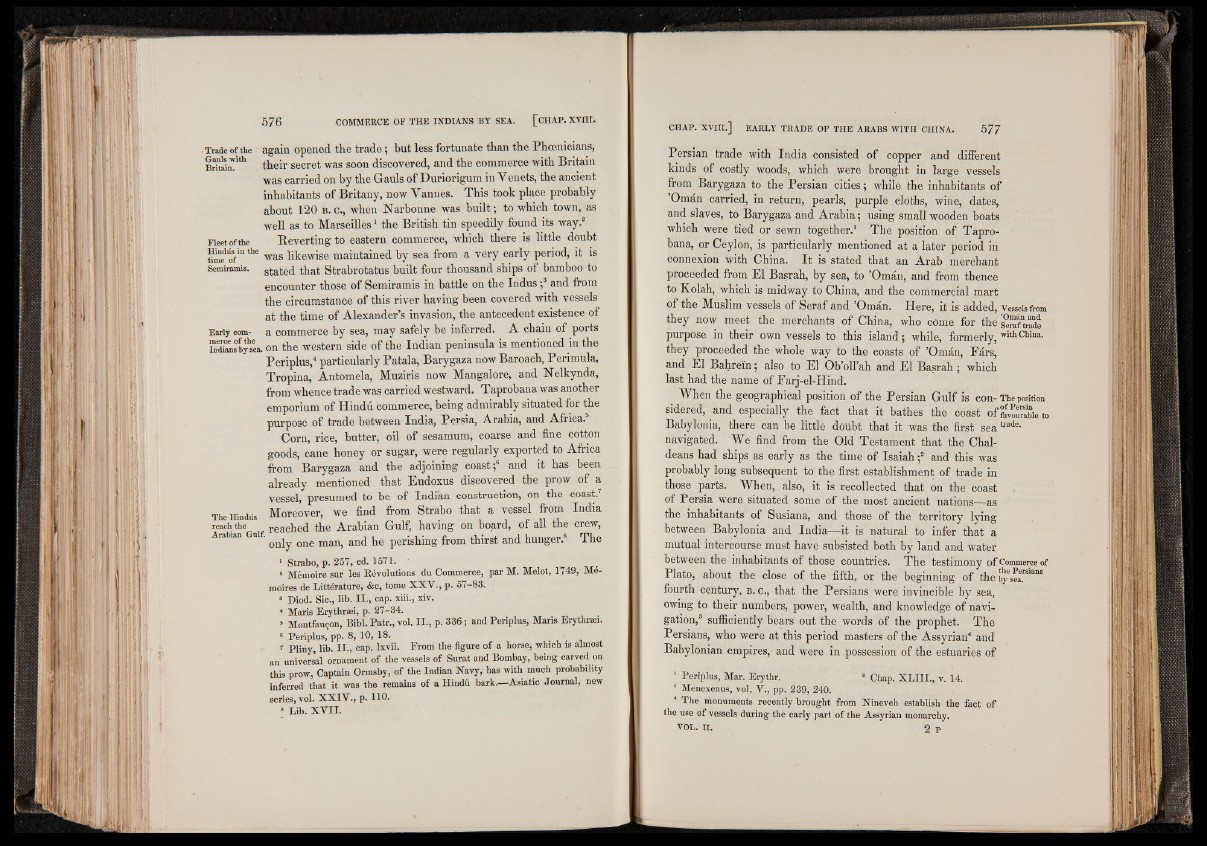
Trade of the again opened the trade 5 but less fortunate than the Phoenicians,
Britain^14*1 their secret was soon discovered, and the commerce with Britain
was carried on by the Gauls of Duriorigum in Venets, the ancient
inhabitants of Britany, now Yannes. This took place probably
about 1 2 0 b . c ., when Narbonne was built; to which town, as
well as to Marseilles1 the British tin speedily found its way.2
Fleet of the Reverting to eastern commerce, which there is little doubt
timedofmthe was likewise maintained by sea from a very early period, it is
Semiramis. stated that Strabrotatus built four thousand ships of bamboo to
encounter those of Semiramis in battle on the Indus ;3 and from
the circumstance of this river having been covered with vessels
at the time of Alexander’s invasion, the antecedent existence of
Early com- a commerce by sea, may safely be inferred. A chain of ports
ïSSishysea. on the western side of the Indian peninsula is mentioned m the
Periplus,4 particularly Patala, Barygaza now Baroach, Perimula,
Tropina, Antomela, Muziris now Mangalore, and Nelkynda,
from whence trade was carried westward. Taprobana was another
emporium of Hindu commerce, being admirably situated for the
purpose of trade between India, Persia, Arabia, and Africa.
Corn, rice, butter, oil of sesamum, coarse and fine cotton
goods, cane honey or sugar, were regularly exported to Africa
from Barygaza and the adjoining coast;6 and it has been
already mentioned that Eudoxus discovered the prow of a
vessel, presumed to be of Indian construction, on the coast.7
The Hindus Moreover, we find from Strabo that a vessel from India
reach the reached the Arabian Gulf, having on board, of all the crew,
Arabian Gulf. j |g || and he perishing from thirst and hunger.8 The
1 Strabo, p. 257, ed. 1571.
8 Mémoire sur les Révolutions du Commerce, par M. Melot, 1749, Mémoires
de Littérature, &c, tome X X V ., p. 57-83.
3 Diod. Sic., lib. I I ., cap. xiii., xiv.
* Maris Erythræi, p. 27-34.
5 Montfauçon, B ib l.P a tr., vol. I I ., p. 3 36; and Periplus, Maris Erythræi.
6 Periplus, pp. 8, 10, 18. _ .
7 Pliny, lib. I I ., cap. lxvii. From the figure of a horse, which is almost
an universal ornament o f the vessels of Surat and Bombay, being carved on
this prow, Captain Ormsby, of the Indian Navy, has with much probability
inferred that it was the remains of a Hindû bark.—Asiatic Journal, new
series, vol. X X IV ., p. 110.
8 Lib. X V I I .
Persian trade with India consisted of copper and different
kinds of costly woods, which were brought in large vessels
from Barygaza to the Persian cities; while the inhabitants of
’Omán carried, in return, pearls, purple cloths, wine, dates,
and slaves, to Barygaza and Arabia; using small wooden boats
which were tied or sewn together.1 The position of Taprobana,
or Ceylon, is particularly mentioned at a later period in
connexion with China. It is stated that an Arab merchant
proceeded from El Basrah, by sea, to ’Omán, and from thence
to Kolah, which is midway to China, and the commercial mart
of the Muslim vessels of Seraf and ’Omán. Here, it is added, Vessels from
they now meet the merchants of China, who come for the SX tra d e
purpose in their own vessels to this island; while, formerly, witIlChina-
they proceeded the whole way to the coasts of ’Omán, Fárs,
and El Bahrein; also to El Ob’oll’ah and El Basrah; which
last had the name of Farj-el-Hind.
^ When the geographical position of the Persian Gulf is con- The position
sidered, and especially the fact that it bathes the coast of favourable to
Babylonia, there can be little doubt that it was the first seatrade-
navigated. We find from the Old Testament that the Chaldeans
had ships as early as the time of Isaiah f and this was
probably long subsequent to the first establishment of trade in
those parts. When, also, it is recollected that on the coast
of Persia were situated some of the most ancient nations—as
the inhabitants of Susiana, and those of the territory lying
between Babylonia and India—it is natural to infer that a
mutual intercourse must have subsisted both by land and water
between the inhabitants of those countries. The testimony of Commerce of
Plato, about the close of the fifth, or the beginning of the byes2.reians
fourth century, B .C ., that the Persians were invincible by sea,
owing to their numbers, power, wealth, and knowledge of navigation,
3 sufficiently bears out the words of the prophet. The
Persians, who were at this period masters of the Assyrian4 and
Babylonian empires, and were in possession of the estuaries of
1 Periplus, Mar. Erythr. 3 Chap. X L I I I ., v. 14.
3 Menexenus, vol. V., pp. 239, 240.
4 The monuments recently brought from Nineveh establish the fact o f
the use of vessels during the early part o f the Assyrian monarchy.
VOL. I I . 2 P